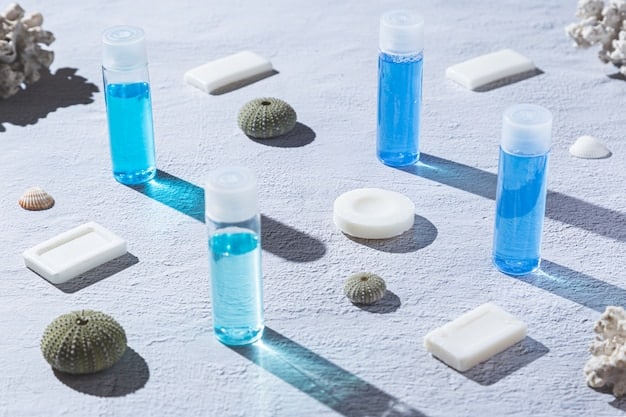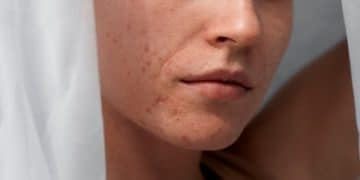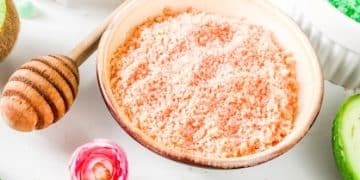The Ultimate Guide to Building a Skincare Routine for Oily Skin in 2025

Crafting the ultimate skincare routine for oily skin in 2025 involves understanding advancements in product formulations, personalized approaches that cater to individual skin needs, and incorporating sustainable practices for a healthy complexion and planet.
Navigating the world of skincare can be overwhelming, especially if you’re dealing with oily skin. But don’t worry, this ultimate guide to building a skincare routine for oily skin in 2025 is here to help you achieve a clear, balanced, and radiant complexion.
Understanding Oily Skin: A 2025 Perspective
Oily skin, characterized by excess sebum production, can lead to concerns like enlarged pores, shine, and acne breakouts. By 2025, advancements in dermatological research offer even more targeted solutions for managing this skin type effectively.
Identifying Oily Skin
Recognizing oily skin is the first step towards creating an effective skincare routine. Key indicators include a glossy shine, especially in the T-zone (forehead, nose, and chin), and a tendency to develop blackheads or whiteheads.
Why is My Skin Oily?
Several factors contribute to oily skin, including genetics, hormonal fluctuations, environmental conditions, and even your diet. Understanding the root causes can help you tailor your routine for optimal results.
- Genetics: Predisposition passed down through families.
- Hormones: Androgens stimulate sebum production.
- Environment: Humid climates can exacerbate oiliness.
- Diet: High glycemic foods can impact sebum levels.
Understanding the factors that contribute to oily skin is crucial for managing it effectively. This knowledge will help you choose the right products and practices to keep your skin balanced and healthy.

Essential Steps in Your 2025 Oily Skin Routine
A well-structured skincare routine is vital for managing oily skin. Each step plays a crucial role in cleansing, balancing, and protecting your skin from potential issues. By 2025, the focus is on multi-functional products and personalized approaches.
Cleansing: The Foundation of Clear Skin
Choose a gentle, foaming cleanser designed for oily skin. Avoid harsh soaps that can strip the skin of its natural oils, leading to increased sebum production as a compensatory mechanism.
Toning: Balancing Your Skin’s pH
Toners help remove any residual dirt or oil after cleansing and can balance the skin’s pH levels. Look for toners containing ingredients like salicylic acid or witch hazel for their oil-controlling properties.
- Salicylic Acid: Exfoliates and unclogs pores.
- Witch Hazel: A natural astringent that reduces oil.
- Glycolic Acid: Promotes cell turnover.
Incorporating a toner into your routine helps maintain your skin’s balance, preventing excess oil production and promoting a clearer complexion.
Targeted Treatments: Serums and Masks for Oily Skin
Serums and masks offer targeted treatments to address specific concerns associated with oily skin. In 2025, these products are more potent and precisely formulated to deliver optimal results.
Serums: Concentrated Solutions
Serums are packed with active ingredients that can penetrate deeply into the skin. For oily skin, look for serums containing niacinamide, hyaluronic acid, or vitamin C.
Masks: Weekly Deep Cleansing
Clay masks are excellent for drawing out impurities and absorbing excess oil. Use them once or twice a week to keep your pores clear and your skin refreshed.
- Clay Masks: Absorb excess oil and impurities.
- Charcoal Masks: Detoxify and minimize pores.
- Hyaluronic Acid Masks: Hydrate without adding oil.
These treatments will help to keep your skin balanced and healthy, addressing specific issues like acne, enlarged pores, and dullness.
Moisturizing Oily Skin: Why It’s Essential
Even oily skin needs hydration. Using a lightweight, oil-free moisturizer can prevent the skin from overproducing oil to compensate for dryness. Look for formulations with hyaluronic acid or glycerin.
Choosing the Right Moisturizer
Gel-based or water-based moisturizers are ideal for oily skin as they provide hydration without clogging pores. Avoid heavy creams or lotions that can leave your skin feeling greasy.
Applying Moisturizer Correctly
Apply moisturizer after cleansing and toning, while your skin is still slightly damp. This helps to lock in moisture and keep your skin hydrated throughout the day.

Sun Protection: A Non-Negotiable Step
Protecting your skin from the sun is crucial, regardless of your skin type. Choose a broad-spectrum, oil-free sunscreen with an SPF of 30 or higher. Reapply every two hours, especially if you’re outdoors.
Physical vs. Chemical Sunscreens
Physical sunscreens, containing zinc oxide or titanium dioxide, are often better for oily skin as they are less likely to cause irritation. Chemical sunscreens absorb UV rays, while physical sunscreens reflect them.
Finding the Right Formula
Look for lightweight, mattifying sunscreens that won’t clog your pores or leave a greasy residue. Gel or fluid formulations are often a good choice for oily skin.
- Zinc Oxide: Provides broad-spectrum protection.
- Titanium Dioxide: Gentle and non-irritating.
- Mattifying Formulas: Control shine and oil.
Sun protection is essential for maintaining healthy, youthful skin, and choosing the right formula ensures that it doesn’t exacerbate oiliness or cause breakouts.
Lifestyle Adjustments: Diet and Habits for Oily Skin
In addition to a dedicated skincare routine, certain lifestyle adjustments can help manage oily skin. Focus on a balanced diet, hydration, and stress management. By 2025, personalized nutrition plans will be even more accessible.
Dietary Changes
Reducing your intake of processed foods, sugary drinks, and high-glycemic carbohydrates can help regulate sebum production. Incorporate more fruits, vegetables, and whole grains into your diet.
Hydration and Sleep
Staying well-hydrated and getting enough sleep are crucial for overall skin health. Aim for at least eight hours of sleep per night and drink plenty of water throughout the day.
- Balanced Diet: Fruits, vegetables, whole grains.
- Hydration: Drink plenty of water.
- Stress Management: Practice relaxation techniques.
Making these lifestyle adjustments can complement your skincare routine, leading to healthier, more balanced skin.
| Key Aspect | Brief Description |
|---|---|
| 💧 Proper Cleansing | Use a gentle, foaming cleanser to remove excess oil and impurities without stripping the skin. |
| ⚖️ pH Balancing | Incorporate a toner with ingredients like salicylic acid or witch hazel to balance skin’s pH and control oil. |
| 🛡️ Sun Protection | Apply a broad-spectrum, oil-free sunscreen daily to protect skin from sun damage without clogging pores. |
| 🥑 Diet and Hydration | Maintain a balanced diet, stay hydrated, and manage stress to support overall skin health. |
Frequently Asked Questions
▼
Washing your face twice a day is typically recommended for oily skin. Over-washing can strip the skin of its natural oils, leading to increased oil production.
▼
Yes, but choose non-comedogenic oils like jojoba or grapeseed oil. These oils mimic the skin’s natural sebum and can help balance oil production.
▼
Pore strips can provide temporary relief from blackheads but can also irritate the skin. Use them sparingly and follow with a soothing toner.
▼
Exfoliation is key for oily skin as it helps remove dead skin cells that can clog pores. Aim to exfoliate 1-2 times per week with a gentle scrub or chemical exfoliant.
▼
Avoid products containing heavy oils like coconut oil, as well as alcohol-based toners that can dry out the skin and lead to increased oil production.
Conclusion
Building the ultimate skincare routine for oily skin in 2025 involves understanding your skin’s specific needs, choosing the right products, and making healthy lifestyle adjustments. With the right approach, you can achieve a clear, balanced, and radiant complexion.





